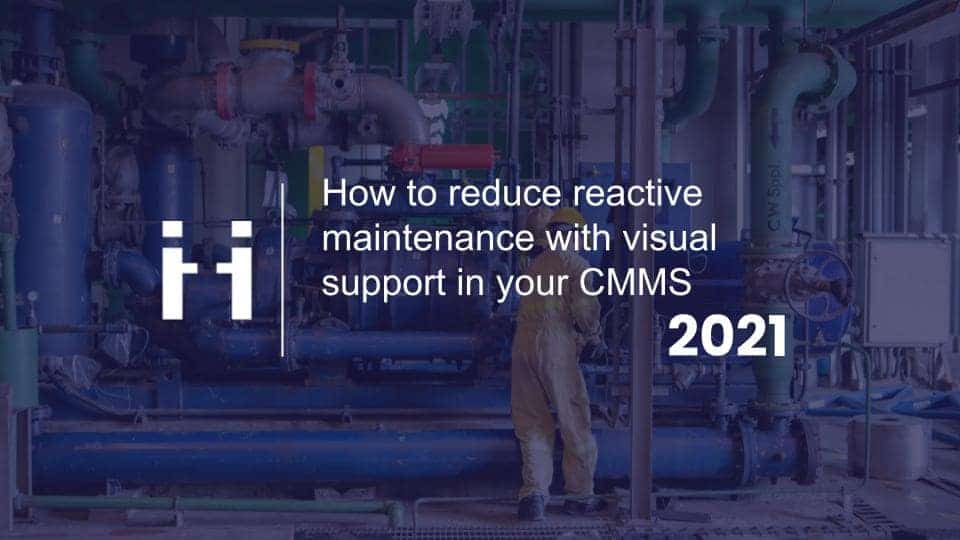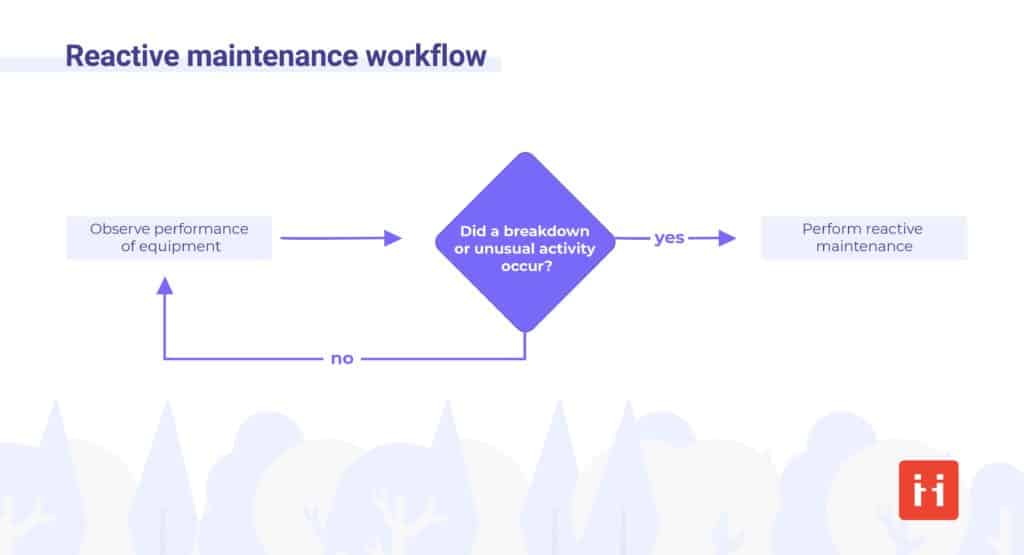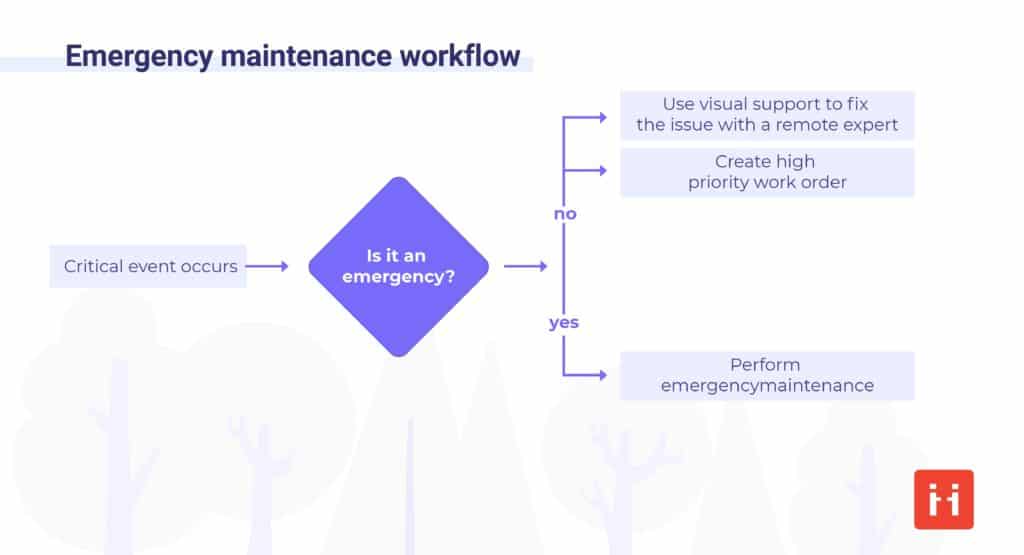
Share this article
Share this article
Reactive maintenance (also known as breakdown maintenance) refers to repairs that need to be carried out when equipment has already broken down. It is often logged for emergency, immediate, or urgent action, in order to restore the asset to its normal operating condition with minimal downtime.
In the world of facility management, whether it be managing the assets in a block of offices, senior-citizens apartments, or manufacturing plant, reactive maintenance is the maintenance undertaken to repair or replace a component after it has failed. It is also known as corrective maintenance, or breakdown maintenance, and involves deliberately allowing an asset to fail before any remedial action is taken.
Facility managers are constantly under pressure to reduce maintenance costs while maintaining all their assets in full working order. No easy task in a 24/7 manufacturing plant. While reactive maintenance has its place in any well-organized maintenance strategy, it should always be approached with caution. The industry norm for the use of reactive maintenance is something less than 10% of an effective maintenance strategy, although this will vary with the type of facilities being managed.

Emergency maintenance workflow is, by its very nature, difficult to correlate. Certain tasks, such as replacing office lightbulbs, can be easily fitted into the working day. However, emergency breakdowns, where components on a critical asset fail unexpectedly, resulting in production downtime, also fall under the reactive or corrective maintenance blanket.
In this situation, it is all hands to the pumps to minimize downtime. The facility manager needs to plan for such eventualities. Maintenance engineers should be fully aware of what is expected of them from the moment an emergency maintenance work number is generated, to the completion of the repair and return of the asset to productive operation.
Corrective maintenance can be incorporated into a general maintenance program. Where some may be planned maintenance and some unplanned (emergency) maintenance.
The three main areas of corrective maintenance include the following.
• When regular asset monitoring reveals an issue
• When normal maintenance or inspection highlights a potential fault
• When an asset breaks down
Corrective maintenance has its place in any maintenance strategy and should be considered another tool in the CMMS toolbox. As with other types of maintenance, technicians can create corrective maintenance work orders to resolve with visual support integrated into the CMMS system.
The main areas where corrective maintenance could be considered include returning a piece of equipment to its full operating status. A full service of an asset as per its manufacturer’s handbook. The rebuilding of an asset from parts salvaged from a scrapped machine. The complete stripping of machine or asset and replacement of all worn parts with new ones.
The majority of these tasks can be a part of a planned schedule. Undertaken when manpower, workload, and finances allow.

There are several advantages to reactive maintenance when considering how to develop a team’s maintenance strategy.
• Overall costs are lower, with no or little start-up or upfront finance required
• Minimum maintenance strategies or job planning needed
• Fewer maintenance engineers required on a day-to-day basis
In the managing of a senior-citizens apartment block, a large percentage of procedures are likely to use a reactive maintenance strategy, as it is more cost-effective in these scenarios.
Such things as changing light bulbs, repairing toilet cisterns, blockages, squeaky doors, and jamming windows, would all be repaired when the breakdown is flagged by a disgruntled resident. Assets such as communal lifts, automatic doors, and heating systems however, should fall under the proactive maintenance banner.
When a machine suddenly stops working, on-site technicians need to resolve the issue as quickly as possible. ViiBE’s visual support solution assigns custom tags, a call center, and timetable availabilities to all experts. Then, if a technician needs support to react to an urgent maintenance situation, but doesn’t know who to call, they can simply select the type of expertise they need support from.
The request will automatically route to all available experts with that assigned skill. The first expert to accept the call request will connect with the technician. Once in the call, both parties have access to collaborative and AR tools so the expert can remotely guide the technician in diagnosing and resolving the problem.
There is little requirement for reactive or corrective maintenance in the world of manufacturing. Where the breakdown of a single asset can bring production to a halt. Managers in these areas need to take a long hard look at any asset they are considering maintaining on a reactive basis and consider the following.
• The breakdown of any asset essential to a plant’s overall productivity will quickly see breakdown costs spiraling
• Reactive maintenance and emergency breakdowns make maintenance budgeting very difficult
• The need to source emergency spares can increase delays
• Pressures for a fast repair can lead to corner-cutting and put technicians in danger
• Reactive maintenance costs can increase by up to 40% compared to proactive costs
• Unless combined with proactive maintenance, asset reliability will deteriorate

Reactive maintenance strategies can result in higher costs for companies. Some of those costs are listed below.
• Excess equipment damage increases repair costs
• It’s difficult to accurately schedule and plan for reactive maintenance
• Worksite safety may be compromised if the machine doesn’t work properly
• The full lifecycle of the machine isn’t optimized
• Companies may face additional costs to receive machine parts quickly
• Downtime may lead to temporary layoffs or plant closures
• It may lead to overtime hours for the technicians performing the repairs
In conclusion, there is no way to completely eliminate the need for emergency maintenance, irrespective of the maintenance regime employed.
All that can be done is provide a mix of proactive maintenance strategies using the key performance indicators sourced from the information on your CMMS software. Reactive, corrective, or run to fail strategies, should only ever be considered on assets whose failure does not impact the operation of other machinery, and does not compromise manufacturing or other business operations.

In an emergency, technicians and maintenance personnel can use visual support tools such as ViiBE to fix issues quickly while working within the parameters of crucial safety guidelines. In an emergency, technicians can generate a report by recording an incident, capturing event details, and uploading it to a work order in their EAM or CMMS system. This is a way to capture a problem if it is not a consistent problem.
This same technology can be used to monitor machines more closely, even if the machine expert isn’t always on-site. As a result, technicians can identify potential issues more quickly, create work orders for preventive maintenance, and therefore, avoid emergency, machine breakdown situations.
Free E-book available now!